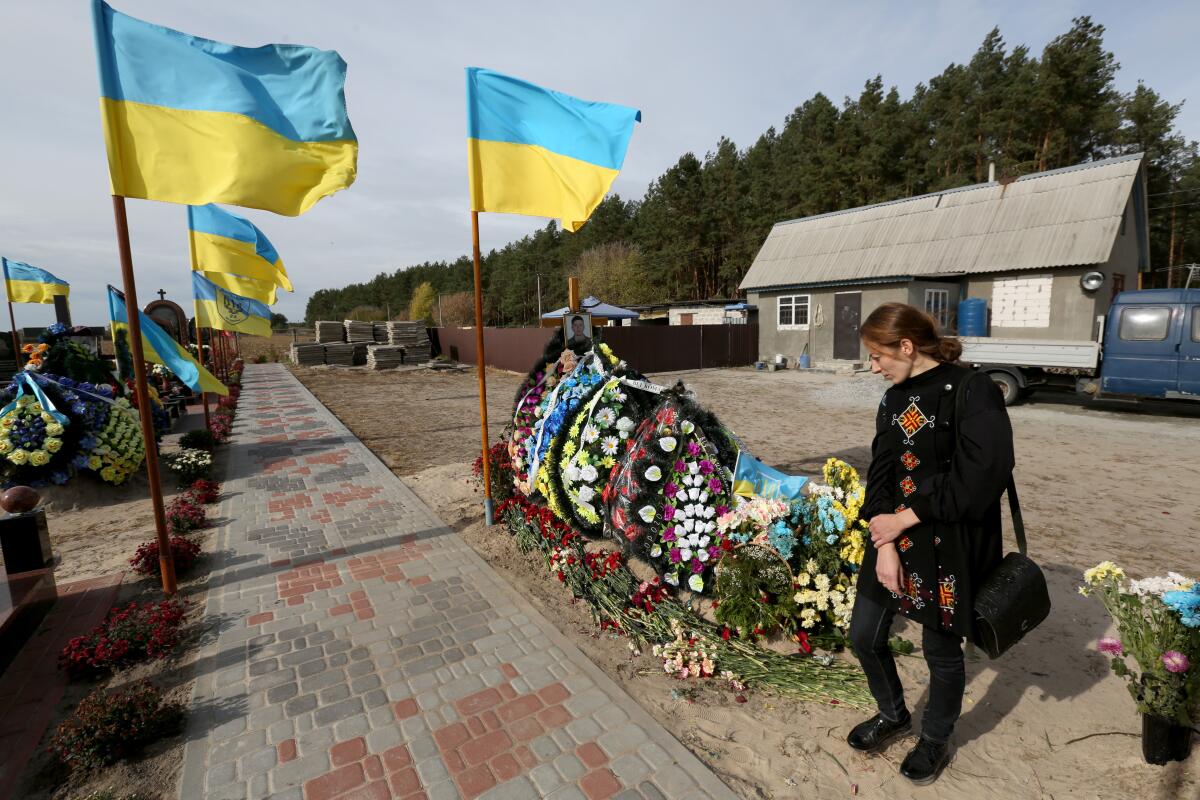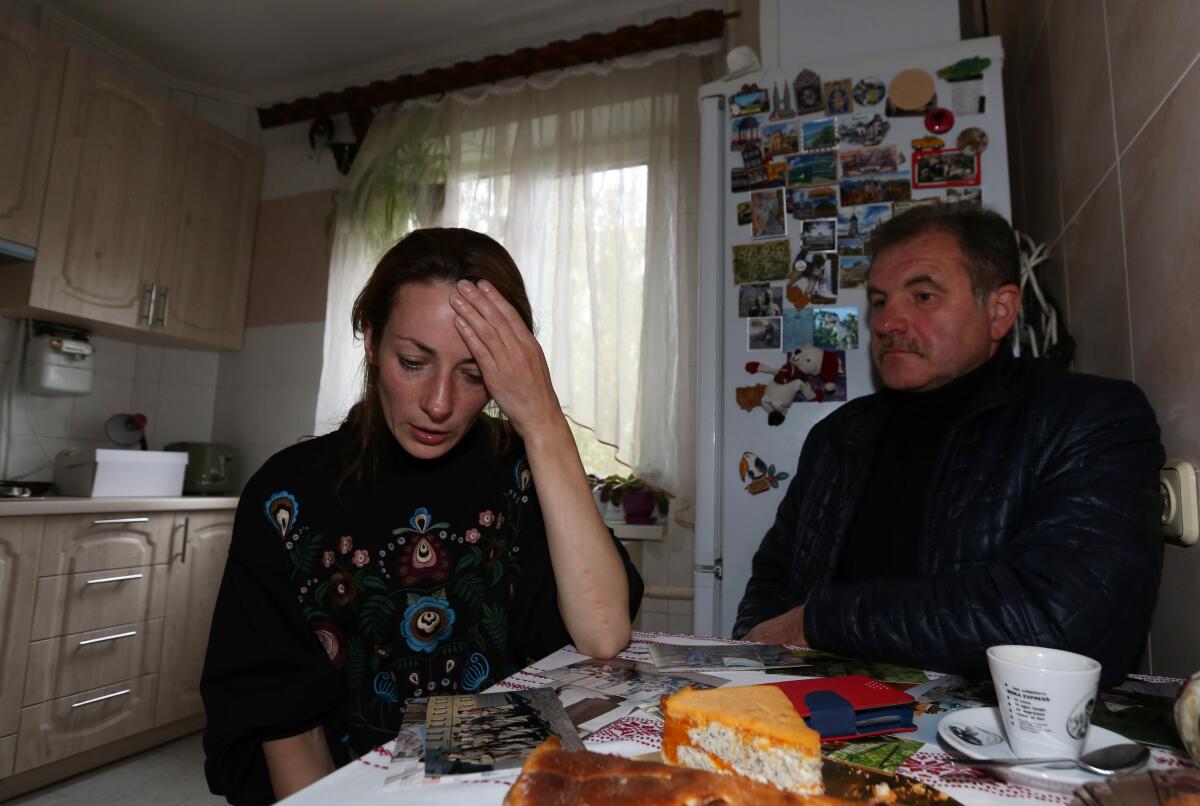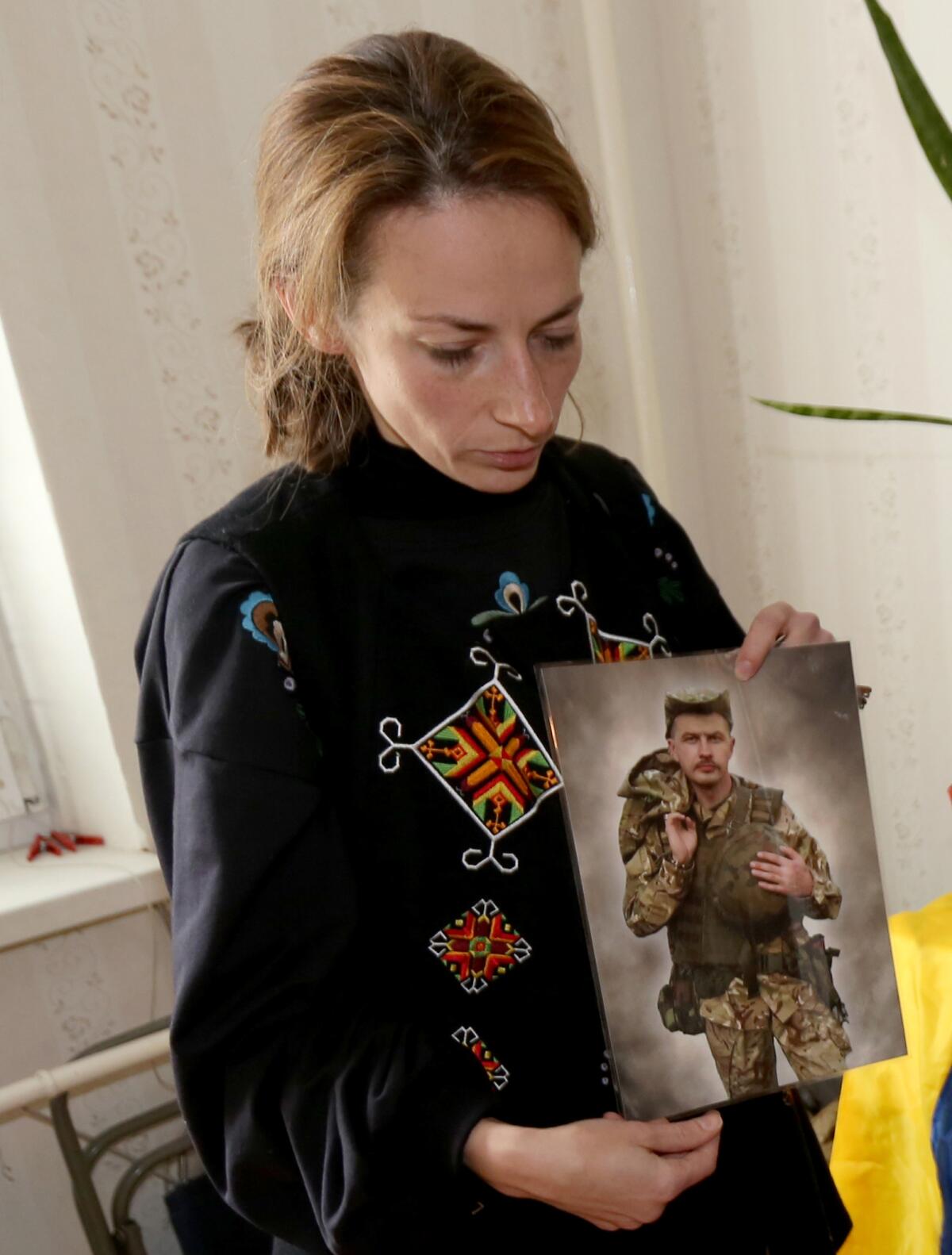Trump froze military aid — as Ukrainian soldiers perished in battle

- Share via
OBUKHIV, Ukraine — When President Trump froze hundreds of millions of dollars in security assistance to Ukraine in July, Oleksandr Markiv was in a trench defending his country’s eastern front line against Russia-backed separatist militias.
Two months later, Markiv, 38, was dead, killed by shrapnel during a mortar attack on his battalion’s position in a notoriously dangerous defense point known as the Svitlodarsk Bulge.
Markiv was one of 25 Ukrainian fatalities on the front line since July 18, the day Trump quietly put on hold a $391-million military aid package appropriated by Congress for Ukraine last year.
Democrats accuse Trump of holding Ukraine’s allotted military aid hostage in exchange for promises from Ukrainian President Volodymyr Zelensky to investigate the dealings of Trump’s political rival, Joe Biden.
Although there is no way to link Markiv’s or the dozens of other deaths directly to the lack of aid, military officials and other Ukrainians say they felt exposed, vulnerable and, at least temporarily, abandoned by their foremost ally: Washington.
“U.S. aid to Ukraine has been very complex and fluid, alternating between more economic aid in the 1990s to more civil society support after 2004 to more military assistance after 2014,” said Rory Finnin, a professor of Ukrainian studies at Cambridge University in the United Kingdom. “Holding [aid] hostage to political whim risks more casualties and undermines decades of American support for this strategically important country,”
Although the Trump administration said in September that it had lifted the freeze on military aid, it “has not reached us yet,” Oleksandr Motuzianyk, a spokesman for the Ukrainian Defense Ministry, said this week. “It is not just money from the bank. It is arms, equipment and hardware.”
At the time Russian President Vladimir Putin annexed Ukraine’s Crimean peninsula and the war was breaking out in Donbas, Ukraine’s armed forces and its equipment had been stripped down and sold off under then-President Viktor Yanukovich. The Kremlin-favored leader was ousted in the Maidan protests in 2014 and fled to Russia.
Tens of thousands of Ukrainians, like Markiv, volunteered to help fight the Russia-backed separatists in the east. Many of them were sent to the front line wearing sneakers and without flak jackets and helmets, let alone rifles and ammunition. Ukrainians across the country organized in an unprecedented, united civil movement not seen since World War II to raise money to supply their ragtag military with everything from soldiers’ boots to bullets.
The West, including the U.S., stepped in to provide billions of dollars in security assistance that included armored Hummer SUVs, military ambulances and medical supplies, radar and communications equipment, night-vision goggles and drones.
Bolstering Ukraine’s battle against Russia in the Donbas follows decades of what the U.S. saw as vital support for the country of 45 million’s post-Soviet transition.
Washington has poured money into developing and stabilizing Ukraine as a way to bring it into the Western fold. This irritated the Kremlin, which sees Ukraine as belonging firmly in Moscow’s perceived sphere of influence.
Whereas Ukraine had been for nearly three decades at the center of a tug of war between the West and Moscow, Trump’s July phone call with Zelensky turned Ukraine into a battlefield for American domestic politics that comes at a high price for Ukrainians fighting on the front line.
“If the United States will drag us into their domestic affairs instead of supporting us … then you start to think on who could you rely?” said Hanna Hopko, a former member of Ukraine’s parliament, the Rada, where she was the leader of its committee on foreign affairs. Hopko is now the co-founder of a new nongovernmental organization lobbying for democratic reforms in Ukraine.
Ukraine would have managed to defend itself against Russia without U.S. assistance, but Kyiv’s losses “would have been much heavier,” said Gen. Viktor Muzhenko, who was chief of staff from 2014 until 2019.
The U.S. donations of counter-battery radar systems, which warns troops about incoming mortar and artillery fire and pinpoints where the firing came from, has saved “hundreds if not thousands of our soldiers’ lives,” Muzhenko said.
Oleksiy Tikhonchuk, the commander of Markiv’s battalion, said such a system could have saved his deputy’s life.
On Sept. 27, Markiv’s unit was hit first by a mortar attack, and then rounds of a large-caliber machine gun, Tikhonchuk said.
“All the soldiers were hiding in the trenches, holes and dugouts, but Sasha decided to climb on top of his dugout to visually spot where the fire was coming from to adjust our return fire,” he said, using the diminutive name for Oleksandr. Markiv was struck when their position took a direct hit from a mortar round. He died three hours later during an operation to remove the shrapnel from his head in a military hospital in Svitlodarsk.
Many Ukrainian battalions have the American radar systems, but Markiv’s squad did not, Tikhonchuk said. “That cost him his life.”

In her grief, Markiv’s widow doesn’t want to make her husband’s death about geopolitics.
Anastasia Golota has enough to worry about with their son, Svetoslav, 9, who refuses to believe that his father is dead.

“He gets upset when I go to the cemetery, he tells me he doesn’t think he’s there,” Golota, 37, said as she walked backed to the car from her husband’s grave. Ukraine’s national blue and yellow flags flap in the wind and mark the graves of 34 soldiers from this former chemical factory town killed during the conflict.
More than 14,000 Ukrainians have died and about 1.5 million displaced in the conflict. For many in Ukraine, it’s still hard to accept that Kyiv is in an armed conflict with its neighbor, Russia, with whom it shares deep historical, linguistic and cultural ties. Many Ukrainians and Russians also have family ties on both sides of the border. Golota is half Russian. Her mother moved from Russia to Ukraine as a child during the Soviet Union years.
“I don’t understand what Russia wants from our little country,” said Golota’s mother, Marina.
But Markiv understood perfectly well what Russia’s ambitions were for Ukraine, Golota said. He was a patriot with a deep commitment to Ukraine’s independence, just as his great-grandfather had been as a member of the nationalist, paramilitary Ukrainian Insurgent Army that fought the Soviet Red Army in the 1940s.
He had worked in the Obukhiv tax office in 2010 and watched as Yanukovich helped his business associates divvy up local government offices to run the city like their personal fiefdoms.
Markiv was very principled and hated the endemic corruption in his country under Yanukovich, she said.
When the Maidan revolution started in 2013, she and Markiv took turns standing on the square and taking care of their son at home. Her husband helped drag the wounded to the makeshift medical hospitals set up on Kyiv’s Independence Square at the height of the clashes between government riot police and protesters.
When there was a military draft in March 2014, Markiv signed up as a volunteer.

He joined the 72nd mechanized brigade and became a lieutenant and served two years, surviving several attacks while losing many battalion mates. In 2016, he joined the Rapid Response Brigade of the National Guard, where he became a senior lieutenant of an antiaircraft missile battalion.
In an obituary, friends described Markiv as “a lieutenant only on paper. In life, he was an ordinary, sociable and reliable fellow.” He wasn’t below peeling potatoes in the trenches with those ranked below him, they said.
But the death of Golota‘s husband is also the story of a Ukrainian soldier changed by war.
He went to war in 2014 saying he hoped his bullets didn’t kill anyone, Golota said. When he was on the front, he would lie to his wife about his location and tell her he was at a training base so she wouldn’t worry, she said.
But after his first tour, Markiv was different, she said. When he was home on leave, his mind was on war. He was constantly checking YouTube for updated videos about what was happening on the front, Golota said.
“He just could not return to life in peace,” she said.
When he returned from training at a U.S.-led joint operation center in western Ukraine in 2016, a program run as part of the American security aid package, Markiv told his wife that the foreign assistance helped, but it wouldn’t be enough.
“It is up to us Ukrainians to fight this war,” he told his wife.
As Trump’s impeachment inquiry continues in Washington, Ukrainians take little consolation in the fact that their country will continue to be in the headlines of American politics.
“It may be a good thing that thanks to their domestic infighting, Trump once again found Ukraine on the world map,” said Stepan Yeremko, 24, a veteran of the war in the east and now a driving instructor in Kyiv, the capital. “But Trump is a businessman. He doesn’t care for democracy or freedom. He doesn’t care if we survive in the war against Russia or not.”
Perhaps now, Trump wishes he’d never meddled with Ukraine, Yeremko said.
More to Read
Sign up for Essential California
The most important California stories and recommendations in your inbox every morning.
You may occasionally receive promotional content from the Los Angeles Times.











